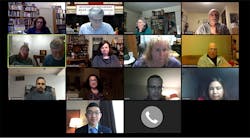COVID-19 has really done a number on the economy, leading to reevaluation of the need and worth of just about everything. The pandemic has forced the cancellation of almost every tradeshow and large gathering. And those not employing masks and social distancing have at times led to major spikes in infections and deaths.
Cancellation of large events and closing of things like schools has forced many to turn to teleconferencing and video conferencing. Virtual conferences are now the name of the game, along with webinars. The number of webinars that we here at Endeavor Business Media are hosting has increased as companies scramble to get their message out to those with dollars still left to spend.
Distance learning has changed from the exception to the rule, while other areas that were doing some remote interaction like telemedicine are seeing massive growth in only a few months. Tools such as Zoom and Microsoft Teams have becoming ubiquitous rather than a growing niche.
Unfortunately, going from an in-person interaction to a virtual one isn’t always easy. I was able to help change the Mercer Science and Engineering Fair I work with into a virtual event within a couple weeks. I knew the tools and reconstructed the infrastructure to handle judging via video conferencing. It not only required getting judges and students together on a Zoom conference, but also having students upload photos and other materials for the judges to examine. The effort would not have succeeded without those involved tackling new procedures and dealing with cantankerous computers, cameras, and content.
Distance learning is neither cheap nor easy, and the results aren’t always great if the sufficient effort and proper methods aren’t employed. Likewise, those using and supporting these solutions need to keep in mind that the different approaches may be better or worse compared to the alternatives. Often, it’s easier for attendees to watch recorded sessions at their leisure rather than try to match the schedule at in-person events. In theory, someone utilizing recorded sessions could see more sessions because they no longer must include travel time and scheduling is obviously easier.
The question is: How valuable are remote interactions versus in-person meetings? Obviously, remote meetings are the norm these days because of the pandemic. Do the advantages of remote meetings offset disadvantages compared to in-person meetings, and should the cost of using remote access be higher or lower?
Many encounter the “free” versions of these tools or the cost is absorbed by the provider. A related issue is that some revamped in-person conferences that charged for attendance were now “free” as they went virtual. Switching back to a paid conference and still remain virtual could be a challenge. Likewise, telemedicine is having issues with some insurance companies wanting to pay less for remote sessions, even though they may actually take more time for both parties.
These cost issues aren’t unique to one environment. Users may not be aware of other possible costs. For example, telemedicine security requirements and associated software will likely be higher than hosting a webinar that’s open for registration to anyone. There are even opportunities such as the ability to more easily track attendees and/or provide incremental pricing—for instance, making keynotes free, having a fixed set of sessions for a fee, and maybe additional fees for specific training sessions.
One certainty is that the focus on remote-access solutions has skyrocketed and innovation is coming in this area. It means examining new options for marketing and learning, as well as in areas such as development, service and support. Determining the worth of the remote-access technology and presentation of content in a remote fashion is something we will all have to do as we move toward a new norm.


